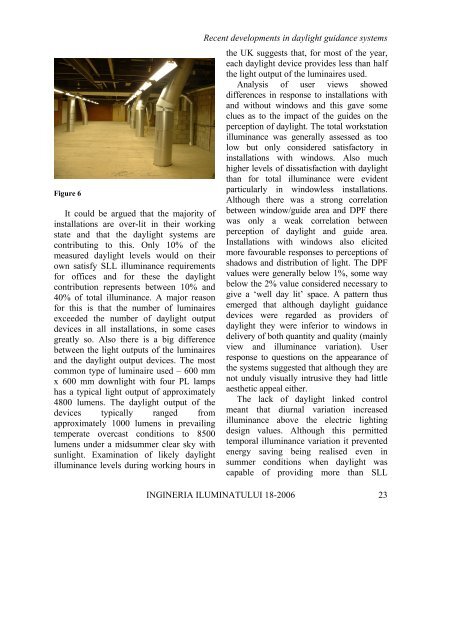This issue is sponsored by the Philips Romania, Lighting Division
This issue is sponsored by the Philips Romania, Lighting Division
This issue is sponsored by the Philips Romania, Lighting Division
You also want an ePaper? Increase the reach of your titles
YUMPU automatically turns print PDFs into web optimized ePapers that Google loves.
Figure 6<br />
It could be argued that <strong>the</strong> majority of<br />
installations are over-lit in <strong>the</strong>ir working<br />
state and that <strong>the</strong> daylight systems are<br />
contributing to th<strong>is</strong>. Only 10% of <strong>the</strong><br />
measured daylight levels would on <strong>the</strong>ir<br />
own sat<strong>is</strong>fy SLL illuminance requirements<br />
for offices and for <strong>the</strong>se <strong>the</strong> daylight<br />
contribution represents between 10% and<br />
40% of total illuminance. A major reason<br />
for th<strong>is</strong> <strong>is</strong> that <strong>the</strong> number of luminaires<br />
exceeded <strong>the</strong> number of daylight output<br />
devices in all installations, in some cases<br />
greatly so. Also <strong>the</strong>re <strong>is</strong> a big difference<br />
between <strong>the</strong> light outputs of <strong>the</strong> luminaires<br />
and <strong>the</strong> daylight output devices. The most<br />
common type of luminaire used – 600 mm<br />
x 600 mm downlight with four PL lamps<br />
has a typical light output of approximately<br />
4800 lumens. The daylight output of <strong>the</strong><br />
devices typically ranged from<br />
approximately 1000 lumens in prevailing<br />
temperate overcast conditions to 8500<br />
lumens under a midsummer clear sky with<br />
sunlight. Examination of likely daylight<br />
illuminance levels during working hours in<br />
Recent developments in daylight guidance systems<br />
<strong>the</strong> UK suggests that, for most of <strong>the</strong> year,<br />
each daylight device provides less than half<br />
<strong>the</strong> light output of <strong>the</strong> luminaires used.<br />
Analys<strong>is</strong> of user views showed<br />
differences in response to installations with<br />
and without windows and th<strong>is</strong> gave some<br />
clues as to <strong>the</strong> impact of <strong>the</strong> guides on <strong>the</strong><br />
perception of daylight. The total workstation<br />
illuminance was generally assessed as too<br />
low but only considered sat<strong>is</strong>factory in<br />
installations with windows. Also much<br />
higher levels of d<strong>is</strong>sat<strong>is</strong>faction with daylight<br />
than for total illuminance were evident<br />
particularly in windowless installations.<br />
Although <strong>the</strong>re was a strong correlation<br />
between window/guide area and DPF <strong>the</strong>re<br />
was only a weak correlation between<br />
perception of daylight and guide area.<br />
Installations with windows also elicited<br />
more favourable responses to perceptions of<br />
shadows and d<strong>is</strong>tribution of light. The DPF<br />
values were generally below 1%, some way<br />
below <strong>the</strong> 2% value considered necessary to<br />
give a ‘well day lit’ space. A pattern thus<br />
emerged that although daylight guidance<br />
devices were regarded as providers of<br />
daylight <strong>the</strong>y were inferior to windows in<br />
delivery of both quantity and quality (mainly<br />
view and illuminance variation). User<br />
response to questions on <strong>the</strong> appearance of<br />
<strong>the</strong> systems suggested that although <strong>the</strong>y are<br />
not unduly v<strong>is</strong>ually intrusive <strong>the</strong>y had little<br />
aes<strong>the</strong>tic appeal ei<strong>the</strong>r.<br />
The lack of daylight linked control<br />
meant that diurnal variation increased<br />
illuminance above <strong>the</strong> electric lighting<br />
design values. Although th<strong>is</strong> permitted<br />
temporal illuminance variation it prevented<br />
energy saving being real<strong>is</strong>ed even in<br />
summer conditions when daylight was<br />
capable of providing more than SLL<br />
INGINERIA ILUMINATULUI 18-2006 23
















